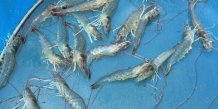Articles

The pathobiome concept could be applied to enhance production of many species, such as shrimp, a major aquaculture product globally
The “pathobiome” – a new understanding of disease
Cefas and University of Exeter scientists have presented a novel concept describing the complex microbial interactions that lead to disease in plants, animals and humans.
Microbial organisms and viruses cause many diseases of plants and animals.
They can also help protect from disease, for example the complex communities of microbes in the human gut, which are very important for our health.
However, very little is known about these microbes and how they cause and prevent disease.
The pathobiome concept opens a door on this unexplored world of microbial diversity and how it controls all other organisms on the planet.
It will change the way we approach health and disease control in animals, plants and humans.
Traditional approaches to describe infectious disease in plants, animals and in humans are based on the concept that single pathogens are responsible for the signs or symptoms of disease observed in those hosts.
The pathobiome concept explains that in reality, disease occurrence is much more complex.
Today sees the publication of a paper exploring the pathobiome concept, a novel way of seeking to understand diseases of plants and animals, including humans.
The concept acknowledges that all organisms are in fact complex communities of viruses, microbes and other small organisms (e.g. parasites) which can interact to affect health or disease status at any given time.
These complex communities continually interact with their hosts, sometimes conferring benefits (e.g. “good” bacteria in the human gut microbiome), and at other times causing harm by contributing to disease.
When these communities combine to cause disease they are termed “pathobiomes” – a recognition of their collective shift away from the healthy-state “symbiome”.
The recognition that the pathobiome plays a key role in those signs and symptoms of disease that we observe in the host is becoming a more accurate way of considering disease than by simply referring to it as the outcome of the effects of a single pathogen (e.g. the influenza virus).
Even when a single agent is implicated, its effects are likely to be modified (enhanced or mitigated) by others in the accompanying pathobiome and so should not be considered in isolation in the disease process.
The influence of the surrounding environment on animal and plant health is hugely important too.
For example, aquatic organisms live in a microbial soup; there are millions of microbes and viruses in every drop of fresh and seawater.
Some of these are already known to cause diseases in different organisms.
In other cases, microbes not previously thought to be pathogenic can, in fact, become so under certain environmental conditions.
As a result of this we are revising our understanding of what a pathogen actually is as we start to recognise that this can be determined by the context in which a microbe finds itself.
Professor David Bass, lead author at Cefas, said: “The vast majority of cells in our bodies are bacterial, not human.
“Therefore, we are walking ecosystems – interacting communities of many different organisms.
“This is also true for all other animals and plants.
“The organisms in these complex communities play key roles in determining the health of their host animals and plants.
“The pathobiome concept will lead to understanding these relationships better and help us manage disease in crop plants and animals, wildlife, pets and ourselves.”
Professor Charles Tyler, of the University of Exeter said: “As we seek to better understand how pathogens cause diseases, we increasingly recognise that the environment, of both the host and pathogen, plays a vital role.
“The concept of the pathobiome seeks to understand how interactions between organisms in, and immediately surrounding, a host, together with the associated physicochemistries of those environments enable or inhibit an organisms’ ability to cause disease.
“As such this presents a more holistic and realistic approach to understanding the disease process.
“It is great to see this conceptual paper coming out of the Centre for Sustainable Aquaculture Futures – a partnership between the University of Exeter and Cefas, where disease diagnosis, avoidance and mitigation of disease in aquaculture is a major focus.”
Professor Grant Stentiford, co-author and Science Theme Lead for Animal and Human Health at Cefas said: “Conceptualising the pathobiome as a community of microbes which have the capacity to change in the host over space (e.g. between tissues and organs) and time, and are associated with observable changes in the health of the host, will revolutionise our understanding of how to describe and manage disease in animals and plants.
“In the case of farmed animals and plants, optimising those conditions which discourage formation of a pathobiome may become as important as existing controls, which aim to minimise exposure to single, specific pathogens.”
The paper, published in the journal Trends in Ecology and Evolution, is entitled: “The pathobiome in animal and plant diseases.”
Date: 12 September 2019
